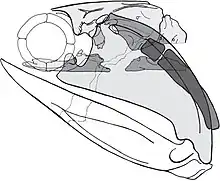| Acanthodes Temporal range: Early Carboniferous to Early Permian | |
|---|---|
 | |
| Acanthodes bronni from the Early Permian of Germany | |
| Scientific classification | |
| Domain: | Eukaryota |
| Kingdom: | Animalia |
| Phylum: | Chordata |
| Class: | †Acanthodii |
| Order: | †Acanthodiformes |
| Family: | †Acanthodidae |
| Genus: | †Acanthodes Agassiz, 1833[1] |
| Species | |
|
See text | |
Acanthodes (from Greek: ἄκανθώδης akanthódis, 'provided with spines')[2] is an extinct genus of acanthodian fish. Species have been found in Europe, North America, and Asia, spanning the Early Carboniferous to the Early Permian, making it one of the youngest known acanthodian genera.[3]
Description

Acanthodes grew to lengths of at least 41 centimetres (16 in).[4] The body was elongate and had a pair of pectoral fins, an unpaired dorsal fin far back on the body, with an unpaired long ventral/pelvic fin and an anal fin on the underside of the body, which like other acanthodians were supported by stiff spines at their front edges. The whole body was covered in scales, which varied in shape depending on their position. The vertebral column was typically unossified.[3] Acanthodes had no teeth and had long gill rakers. Because of this, Acanthodes is presumed to have been a suspension feeder, filtering plankton from the water.[5] A specimen of Acanthodes bridgei was so well-preserved that traces of its eye tissue were sufficient to establish that Acanthodes had both rod and cone photoreceptor cells, suggesting that it was capable of color vision.[6]
Ecology
The various species of Acanthodes are known to have inhabited freshwater lakes,[7] as well as saline lagoons.[8] Acanthodes bronni, which lived in freshwater lakes in southern Germany during the Early Permian, is known to have been fed upon by the temnospondyl amphibians Archegosaurus and Cheliderpeton.[7] Acanthodes was likely capable of opening its jaws wide as an adaptation to suspension feeding.[9]
Taxonomy
The classification of acanthodians was historically contentious, however, in the 2010s based in part based on detailed studies of the skull of Acanthodes, it became widely accepted that acanthodians represented a paraphyletic assemblage of stem-group Chondrichthyes.[10][9] Within the "Acanthodii", Acanthodes is traditionally placed within the Acanthodiformes, which is now also considered to be paraphyletic.[11]
Species
After Beznosov, 2009[3]
- Acanthodes bronni Agassiz, 1833 (type), Germany, Lower Permian
- Acanthodes bourbonensis Heidtke, 1996, Early Permian, France
- Acanthodes boyi Heidtke, 1993, Early Permian, Germany
- Acanthodes bridgei Zidek, 1976, Late Carboniferous (Stephanian), Kansas, USA
- Acanthodes fritschi Zajic, 1998, Late Carboniferous (Stephanian), Czech Republic
- Acanthodes gracilis (Beyrich, 1848), Early Permian, Czech Republic, Poland and Germany
- Acanthodes kinneyi Zidek, 1992, Late Carboniferous (Stephanian), New Mexico, USA
- Acanthodes lopatini Rohon, 1889, Early Carboniferous (Tournaisian), southern Krasnoyarsk Krai, Russia
- Acanthodes luedersensis (Dalquest et al., 1988), Early Permian of Texas, USA
- Acanthodes lundi Zidek, 1980, Late Carboniferous (Namurian), Montana, USA
- Acanthodes nitidus Woodward, 1891, Early Carboniferous (Visean), Scotland
- Acanthodes ovensi White, 1927, Early Carboniferous (Tournaisian), Scotland
- Acanthodes sippeli Heidtke, 1996, Late Carboniferous (Namurian), Germany
- Acanthodes stambergi Zajic, 2005, Early Permian, Czech Republic
- Acantodes sulcatus Agassiz, 1835, Early Carboniferous (Visean), Scotland
- Acanthodes tholeyi Heidtke, 1990, Early Permian, Germany
- Acanthodes wardi Egerton, 1866, Late Carboniferous (Westphalian), England and Scotland.
References
- ↑ Woodward, Arthur Smith (1889). Catalogue of the fossil fishes in the British Museum (Natural History) . London, Printed by order of the Trustees. p. 2.
- ↑ Dean, Bashford (1895). Fishes, living and fossil. An outline of their forms and probable relationships. New York, London, Macmillan and Co. p. 227.
- 1 2 3 Beznosov, Pavel (May 2009). "A redescription of the Early Carboniferous acanthodian Acanthodes lopatini Rohon, 1889". Acta Zoologica. 90: 183–193. doi:10.1111/j.1463-6395.2008.00352.x.
- ↑ Zidek, Jiri (5 May 1976). "Kansas Hamilton Quarry (Upper Pennsylvanian) Acanthodes, with remarks on the previously reported North American occurrences of the genus". The University of Kansas Paleontological Contributions. hdl:1808/3725. Paper 83.
- ↑ H., Arratia Fuentes, Gloria, 1942- ... Schultze, Hans-Peter, 1937- ... Wilson, Mark V. (2013). "The plasticity of gill raker characteristics in suspension feeders: Implications for Pachycormiformes.". Mesozoic fishes. proceedings of the international meeting, Saltillo, 2010. F. Pfeil. ISBN 978-3-89937-159-8. OCLC 859436115.
{{cite book}}: CS1 maint: multiple names: authors list (link) CS1 maint: numeric names: authors list (link) - ↑ Malhotra, Richa (23 December 2014). "Three-hundred-million-year-old fossil fish still has traces of eye tissue". Science. doi:10.1126/article.71687 (inactive 2023-08-01).
{{cite journal}}: CS1 maint: DOI inactive as of August 2023 (link) - 1 2 Kriwet, Jürgen; Witzmann, Florian; Klug, Stefanie; Heidtke, Ulrich H.J (2008-01-22). "First direct evidence of a vertebrate three-level trophic chain in the fossil record". Proceedings of the Royal Society B: Biological Sciences. 275 (1631): 181–186. doi:10.1098/rspb.2007.1170. ISSN 0962-8452. PMC 2596183. PMID 17971323.
- ↑ Beznosov, Pavel (May 2009). "A redescription of the Early Carboniferous acanthodian Acanthodes lopatini Rohon, 1889". Acta Zoologica. 90: 183–193. doi:10.1111/j.1463-6395.2008.00352.x.
- 1 2 Brazeau, Martin D.; de Winter, Valerie (2015-12-22). "The hyoid arch and braincase anatomy of Acanthodes support chondrichthyan affinity of 'acanthodians'". Proceedings of the Royal Society B: Biological Sciences. 282 (1821): 20152210. doi:10.1098/rspb.2015.2210. ISSN 0962-8452. PMC 4707761. PMID 26674952.
- ↑ Davis, Samuel P.; Finarelli, John A.; Coates, Michael I. (June 2012). "Acanthodes and shark-like conditions in the last common ancestor of modern gnathostomes". Nature. 486 (7402): 247–250. Bibcode:2012Natur.486..247D. doi:10.1038/nature11080. ISSN 0028-0836. PMID 22699617. S2CID 4304310.
- ↑ Dearden, Richard P.; Giles, Sam (November 2021). "Diverse stem-chondrichthyan oral structures and evidence for an independently acquired acanthodid dentition". Royal Society Open Science. 8 (11): 210822. Bibcode:2021RSOS....810822D. doi:10.1098/rsos.210822. ISSN 2054-5703. PMC 8580420. PMID 34804566.
- Parker, Steve. Dinosaurus: the complete guide to dinosaurs. Firefly Books Inc, 2003. Pg. 60